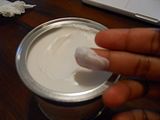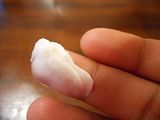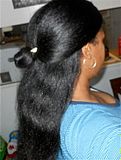Leeda.the.Paladin
Well-Known Member
I put this on my blog but am copying and pasting here. My science skills are not the business  so feel free to chime in
so feel free to chime in 
Crisco’s Background Check
You might have a few preconceived notions about using Crisco on the hair. Here were some that I had:
It will make me smell like fried chicken. Not true. Crisco has no scent as far as I can tell. Honestly, I don’t know why this keeps coming up, but I think it’s the association Crisco has had with lard. (FYI: Crisco is not lard) Now, if you fry some chicken, save the oil and then reuse it on your hair, you might have a problem.
The ingredients are bad for my hair. Well, I guess that would be an individual choice. The ingredients are actually not that bad. From the back of my can:

So we have soybean oil, and then hydrogenated palm and soybean oils. Hydrogenation (ug, get ready for a lil science) is the process of adding hydrogen under pressure to liquid oils which semi-solidifies them. This process is used in a ton of hair care, make up, fragrances, and other beauty products.
Yes, it’s used in a ton of products, but that still doesn’t answer the question of “How safe is it?”
I took my search to SkinDeep which pretty much reports that there is very little to no toxicity or danger associated with the use of hydrogenated vegetable oils. Of course taken internally is a whole ‘nother matter…so hold off on using this to make biscuits too often (though my grandma used to make the BEST pies and biscuits with Crisco!). If you’re someone who only likes to use pure, unrefined oils and ingredients, this might not be for you.
The next ingredient that raised a flag was TBHQ (tertiary butylhydroquinone). I was like, what the heck is this exactly? I did find some alarming articles online about this ingredient but I found just as many that said that the alarmists were alarming for no reason. This is from wikipedia:
Based on the above information and others, I’m not too fussed about that ingredient.
It will “fry” my hair like it fries that delicious chicken. I was torn on this one. Many people use coconut oil and other oils to flat iron their hair.I’ve seen a lot of people who press with Crisco say that it doesn’t boil until around 400-425 degrees Fahrenheit. Therefore, by that reasoning, keeping your appliances below 400 or so will minimize damage. I will present the evidence I’ve found and let you decide for yourself.
In order to find out if Crisco would “cook” one’s hair, I thought I had to find out the boiling points of the two oils that make up Crisco: soybean and palm. Let me tell you, it is very hard to find the exact boiling points for these oils.
I did, however, find the “smoke point” for these oils, though they also vary. The smoke point is when oil is heated so much that it produces smoke and it also starts to degrade nutritionally. When frying, you want to choose oils with a high smoke point, like veggie oils. Palm oil’s smoke point is around 455 degrees F and soybean oil’s is around 460 degrees F (wikiepdia).
I was able to find out from the Department of Physics at the University of Illinois that an oil will reach its smoke point before it reaches its boiling point.
However, these points depend not only the type of oil but also how refined the oil is. So, according to the aforementioned physics site, the boiling point for soybean oil (very refined) would be around 572 degreed F! The less pure an oil is the more heat it can take.
This leads me to believe that the boiling point is not what I should be looking at, but instead the smoke point. And I’m also thinking that’s what people who defend Crisco are referring to when they say “boiling point” but I could be wrong.
NOW, having said allll that…crisco is shortening, not liquid oil. I’ve found out that shortening has a much lower smoke point than regular soybean and palm oil. Crisco recommends frying at 365 to 375 degrees F when using the shortening. Another cooking site I went to had the smoke point of veggie shortening at 325 degrees F.
Take all of the above information and apply your own judgement. I would personally suggest, as I do for all instances when you use heat, to make sure you use the lowest possible setting and use a heat protectant. I typically use my flat iron at about 400. I researched the whole smoke point thing after I flat ironed (smart, I know!)
Of course, none of this matters if you use it without heat.
Last notion: It just ain’t right to use shortening on your hair! Ok it does seem weird. But using honey, molasses, and bananas on my hair seemed weird 5 years ago. If you’re still of the mind that it ain’t right, check out this article from The Natural Haven.
If you’ve never seen Crisco, it is a white thick, almost buttery feeling semi-solid. I’ve heard it compared to mayonnaise and I can’t understand the comparison. Mayo is what I would call “gloppy” and Crisco isn’t like that at all. It is very rich and spreads easily. As I said, I can detect no odor. The price was $2.89 at my local grocery store.


I didn’t start out using Crisco for flat ironing, even though that is what it seems to receive the most praise for.
I used it on dry hair first. My results? Very soft hair. I also thought it would be hella greasy like a petroleum product, but it really wasn’t. I started out using it sparingly but found that I could actually apply a bit more than was often suggested.
I did not find it be moisturizing when used alone. I’m not surprised as oils don’t generally do much for moisture as a rule. I think this is an excellent choice for sealing and that’s what I used it for.
I also found a lot of reports of Crisco imparting sheen, even without flat ironing. I did not find this to be the case when applying it to a dry natural style. I did find that it lent more sheen when I used it on wet hair.
As for my flat ironing experience, I do have to say that this was probably the best press I’ve ever done. My hair was extremely soft with minimal greasiness (I could feel the product but only lightly), it was shiny (though straight hair usually does shine), and it got pretty darn straight.
Here was my routine:

I’ve since used it a few times on my flat ironed hair when it felt dry. It feels moisturized after I use it but the feeling doesn’t last long. So, again, doesn’t do much for me in the moisture department.
In addition to using it on my hair, I’ve been using it on my skin. It has been doing wonders for my dry, rough feet. After a bath, it can be a bit much, so use it sparingly. But even when I used too much, I didn’t stay greasy long
I can’t say that Crisco is the only thing I will ever use on my skin and hair (because as a product junkie, I can’t completely commit!) but it will definitely enter the rotation. Especially at that price.
Some other interesting facts about Crisco:
 so feel free to chime in
so feel free to chime in 
Crisco’s Background Check
You might have a few preconceived notions about using Crisco on the hair. Here were some that I had:
It will make me smell like fried chicken. Not true. Crisco has no scent as far as I can tell. Honestly, I don’t know why this keeps coming up, but I think it’s the association Crisco has had with lard. (FYI: Crisco is not lard) Now, if you fry some chicken, save the oil and then reuse it on your hair, you might have a problem.
The ingredients are bad for my hair. Well, I guess that would be an individual choice. The ingredients are actually not that bad. From the back of my can:
So we have soybean oil, and then hydrogenated palm and soybean oils. Hydrogenation (ug, get ready for a lil science) is the process of adding hydrogen under pressure to liquid oils which semi-solidifies them. This process is used in a ton of hair care, make up, fragrances, and other beauty products.
Yes, it’s used in a ton of products, but that still doesn’t answer the question of “How safe is it?”
I took my search to SkinDeep which pretty much reports that there is very little to no toxicity or danger associated with the use of hydrogenated vegetable oils. Of course taken internally is a whole ‘nother matter…so hold off on using this to make biscuits too often (though my grandma used to make the BEST pies and biscuits with Crisco!). If you’re someone who only likes to use pure, unrefined oils and ingredients, this might not be for you.
The next ingredient that raised a flag was TBHQ (tertiary butylhydroquinone). I was like, what the heck is this exactly? I did find some alarming articles online about this ingredient but I found just as many that said that the alarmists were alarming for no reason. This is from wikipedia:
Both the European Food Safety Authority (EFSA) and the United States Food and Drug Administration (FDA) have evaluated TBHQ and determined that it is safe to consume at the concentration allowed in foods.[4] The FDA sets an upper limit of 0.02% of the oil or fat content in foods.[5] At higher doses, it has some negative health effects on lab animals, such as producing precursors to stomach tumors and damage to DNA.[6] A number of studies have shown that prolonged exposure to high doses of TBHQ may be carcinogenic,[7] especially for stomach tumors.[8] Other studies, however, have shown opposite effects including inhibition against HCA-induced carcinogenesis (by depression of metabolic activation) for TBHQ and other phenolic antioxidants (TBHQ was one of several, and not the most potent).[9] The EFSA considers TBHQ to be non-carcinogenic.[4] A review of scientific literature concerning the toxicity of TBHQ determined that there is a wide margin of safety between the levels of intake by humans and the doses that produce adverse effects in animal studies.[10] However, it should also be noted that the review cited in the last sentence took place some time ago (1986).
Based on the above information and others, I’m not too fussed about that ingredient.
It will “fry” my hair like it fries that delicious chicken. I was torn on this one. Many people use coconut oil and other oils to flat iron their hair.I’ve seen a lot of people who press with Crisco say that it doesn’t boil until around 400-425 degrees Fahrenheit. Therefore, by that reasoning, keeping your appliances below 400 or so will minimize damage. I will present the evidence I’ve found and let you decide for yourself.
In order to find out if Crisco would “cook” one’s hair, I thought I had to find out the boiling points of the two oils that make up Crisco: soybean and palm. Let me tell you, it is very hard to find the exact boiling points for these oils.
I did, however, find the “smoke point” for these oils, though they also vary. The smoke point is when oil is heated so much that it produces smoke and it also starts to degrade nutritionally. When frying, you want to choose oils with a high smoke point, like veggie oils. Palm oil’s smoke point is around 455 degrees F and soybean oil’s is around 460 degrees F (wikiepdia).
I was able to find out from the Department of Physics at the University of Illinois that an oil will reach its smoke point before it reaches its boiling point.
However, these points depend not only the type of oil but also how refined the oil is. So, according to the aforementioned physics site, the boiling point for soybean oil (very refined) would be around 572 degreed F! The less pure an oil is the more heat it can take.
This leads me to believe that the boiling point is not what I should be looking at, but instead the smoke point. And I’m also thinking that’s what people who defend Crisco are referring to when they say “boiling point” but I could be wrong.
NOW, having said allll that…crisco is shortening, not liquid oil. I’ve found out that shortening has a much lower smoke point than regular soybean and palm oil. Crisco recommends frying at 365 to 375 degrees F when using the shortening. Another cooking site I went to had the smoke point of veggie shortening at 325 degrees F.
Take all of the above information and apply your own judgement. I would personally suggest, as I do for all instances when you use heat, to make sure you use the lowest possible setting and use a heat protectant. I typically use my flat iron at about 400. I researched the whole smoke point thing after I flat ironed (smart, I know!)
Of course, none of this matters if you use it without heat.
Last notion: It just ain’t right to use shortening on your hair! Ok it does seem weird. But using honey, molasses, and bananas on my hair seemed weird 5 years ago. If you’re still of the mind that it ain’t right, check out this article from The Natural Haven.
My Review
If you’ve never seen Crisco, it is a white thick, almost buttery feeling semi-solid. I’ve heard it compared to mayonnaise and I can’t understand the comparison. Mayo is what I would call “gloppy” and Crisco isn’t like that at all. It is very rich and spreads easily. As I said, I can detect no odor. The price was $2.89 at my local grocery store.


I didn’t start out using Crisco for flat ironing, even though that is what it seems to receive the most praise for.
I used it on dry hair first. My results? Very soft hair. I also thought it would be hella greasy like a petroleum product, but it really wasn’t. I started out using it sparingly but found that I could actually apply a bit more than was often suggested.
I did not find it be moisturizing when used alone. I’m not surprised as oils don’t generally do much for moisture as a rule. I think this is an excellent choice for sealing and that’s what I used it for.
I also found a lot of reports of Crisco imparting sheen, even without flat ironing. I did not find this to be the case when applying it to a dry natural style. I did find that it lent more sheen when I used it on wet hair.
As for my flat ironing experience, I do have to say that this was probably the best press I’ve ever done. My hair was extremely soft with minimal greasiness (I could feel the product but only lightly), it was shiny (though straight hair usually does shine), and it got pretty darn straight.
Here was my routine:
- Shampoo with Suave Clarifying Shampoo
- Applied homemade protein treatment, rinsed
- Deep Condition with Lustrasilk Shea Plus, detangled, rinsed
- Banded hair with Nexxus Heat Protexx (liquid heat protectant) and let air dry
- Blowdried with comb attachment (on low heat)
- Applied Crisco and flat ironed on 400 degrees F (mostly 2 passes, sometimes 3)

I’ve since used it a few times on my flat ironed hair when it felt dry. It feels moisturized after I use it but the feeling doesn’t last long. So, again, doesn’t do much for me in the moisture department.
In addition to using it on my hair, I’ve been using it on my skin. It has been doing wonders for my dry, rough feet. After a bath, it can be a bit much, so use it sparingly. But even when I used too much, I didn’t stay greasy long
I can’t say that Crisco is the only thing I will ever use on my skin and hair (because as a product junkie, I can’t completely commit!) but it will definitely enter the rotation. Especially at that price.
Some other interesting facts about Crisco:
- Elvis supposedly used it to style his hair back in the ’50s.
- Crisco is an excellent treatment for eczema.
- Oncologists and gynecologists will sometimes recommend Crisco for vaginal dryness.
- Crisco can be used on diaper rash.



 Thanks for sharing!
Thanks for sharing!